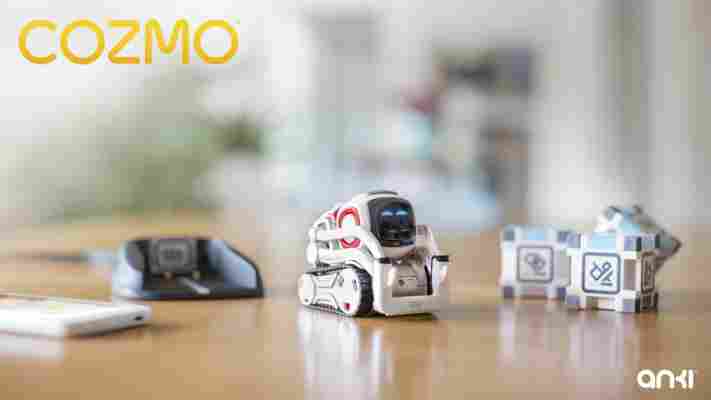Anki just built Wall-E and Eve’s love child into a robot named Cozmo, and it’s incredible
Most people recognize Anki best for its line of toy race cars , but the latest product from the company will excite anyone who’s remotely interested in artificial intelligence, robotics, Pixar movies, or all of the above.

Cozmo is Anki’s newest toy car that’s basically Wall-E and Eve’s lovechild come to life. He’s got the body like Wall-E’s with a mechanical arm that can push, lift things and move things around, or flail to show distress. His face is reminiscent of Eve’s, with two digital oval eyes that displays a variety of emotions.
The team worked with Pixar animators to design a robot toy that not only interacts with you, but moves and reacts in a believable way – similar to how you get immersed into Pixar’s animated world.
Using Anki’s proprietary AI system, the company likens Cozmo to a pet. Out of the box, the toy has a young, playful personality and uses its built-in computer vision to recognize each person it plays with, and grows with them as they get better at games, challenges, and activities.
Cozmo’s personality is one of the most incredible things Anki’s built into a toy. If you poke and toss Cozmo around repeatedly, he might show he’s upset and stops playing with you for a few moment to help kids recognize how to better treat their toy.
This ain’t your average pet rock. For example, in a block-building game, you can leave blocks around for Cozmo to stack. If you mess with Cozmo’s stack by putting another block on top when he hasn’t finished, he might get pissed off and pushes the whole thing over and laughs maniacally (Cozmo doesn’t actually speak, but make Wall-E-like noises to emote his feelings).
The interaction is similar to how a Sim might need a moment to recuperate from being sad or angry before they can go enjoy themselves and play again.
Don’t worry though, Anki CEO Boris Sofman says it’s not designed to become depressed overtime if it plays with the wrong kid. The idea is to push the boundaries of what robotics and AI could emulate to create an experience that’s believable and fun.
Playing with Cozmo in our demo was extremely joyous. Anki even worked with composers to create original scoring that matches moments you interact with Cozmo, such as the time he first meets and learns who you are, or the first game you play together. It’s like living your own Pixar film.
Cozmo also remembers each interaction it has with you (say, versus a sibling) so it knows whether you’re at an easier level when playing a color matching game, or if you’re a pro and the toy needs to step up to properly challenge you.
While other smart toys, like the IBM Watson-powered CogniToy dinosaur , offer a great range of intelligence and education, they typically rely on the player to initiate the interaction. If you leave Cozmo to explore your desk, he might be the one to come up to you and introduce a new game to play.
When Cozmo launches in October for $179 , Anki plans to open up its AI SDK to let developers help create more games or interactions between the player and the toy. It’s an exciting look at where the future of robotics and toys could go, and it doesn’t hurt Anki to play into the hands of the kids and kids at heart who look to Disney and Pixar as their guide to what the world would be like if non-human objects had a personality.
Apple confirms its T2 chip will block some third-party repairs
Apple confirmed yesterday that its new security chip T2 – which it uses in MacBooks launched this year – will prevent third-party repairs to some degree.

Responding to a query from The Verge , the company verified that parts like the logic board and Touch ID components for the new Macbooks can’t be replaced by a third-party repair shop – and so you’ll have to visit an authorized Apple service center to get your laptops fixed. However, it didn’t confirm if this extends to last year’s iMac Pro – the T2 chip’s first host.
Details about Apple’s new chip blocking third-party repairs surfaced last month, when Motherboard and MacRumors got their hands on an internal document. It suggested that a special piece of software – available only to authorized service centers – will check if the replaced parts are authentic.
“(The T2 is) a guillotine that [Apple is] holding (over product owners),” said iFixit CEO’s Kyle Wiens . “It’s very possible the goal is to exert more control over who can perform repairs by limiting access to parts. This could be an attempt to grab more market share from the independent repair providers. Or it could be a threat to keep their authorized network in line. We just don’t know.”
The new chip’s job is to make the boot process and Touch ID more secure. So it makes sense that Apple is preventing unauthorized shops from replacing critical parts. However, it’s unclear if the T2 chip also restricts replacements for more common parts like the display, speaker, and keyboard .
Intriguingly, Apple seems to have not activated third-party repair blocking just yet. In an experiment, iFixit was able to replace the screen, logic board, and Touch Bar in a new MacBook Pro by using components from a MacBook Pro purchased this summer. Apple confirmed to The Verge that a configuration software is not required to validate screen replacement. Of course, the company could flip the switch on this at any time.
Meanwhile, Apple is trying to make certain component repairs less painful. According to a report by MacRumors , it’s now easier than ever before to replace the battery on the new MacBook Air.
The company is currently fighting “right to repair” legislation in the US, which would require hardware companies to make repair parts, repair guides, tools, and diagnostic software publicly available.
The problem of Apple preventing third-party repairs not only affects the cost of ownership of its products, but it could also spell trouble for service centers outside of the company’s network. But if the replacement limit is on a few parts, it probably won’t debilitate your neighborhood repair shop. We’ll have to wait and watch if more common parts’ repairs are restricted by the T2 chip.
There’s now an unofficial way to play Oculus VR games on the HTC Vive
Console gamers have had to put up with hardware makers’ ploy to woo them with exclusive titles for years, and now the same thing is starting to happen with VR headsets.

Games for the HTC Vive are designed to work with any headset. Meanwhile, Oculus launched its own gear last month with a couple of games that would only work with the company’s VR headset and has a content store that only recognizes the Rift.
Developer CrossVR is having none of that – he’s created Revive , a compatibility layer for Windows that lets you run Lucky’s Tale as well as Oculus Dreamdeck on your HTC Vive.
To try it yourself, you’ll need to patch the games that you’ve purchased from the Oculus store with the CrossVR’s Revive project files and simple instructions that are available on GitHub .
At present, CrossVR says that he’s only tested the two aforementioned titles – but some Redditors have found other games to work just as well.
Currently, you’ll need an Xbox controller to play these games. CrossVR hopes to bring support for Oculus Touch titles which should work with the Vive’s handheld controllers. OpenGL and DX12 support and multiplayer functionality are also on the cards.
It’ll be interesting to see how Oculus responds to this. CrossVR told UploadVR that he hopes Oculus “will choose to see this in a positive light, this compatibility has the potential to bring much more customers to their store.”
Update: Oculus has issued a statement on the matter:
